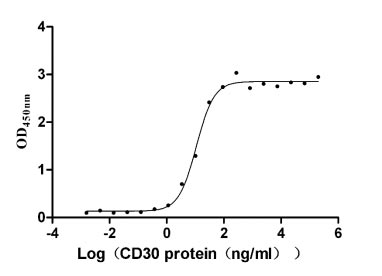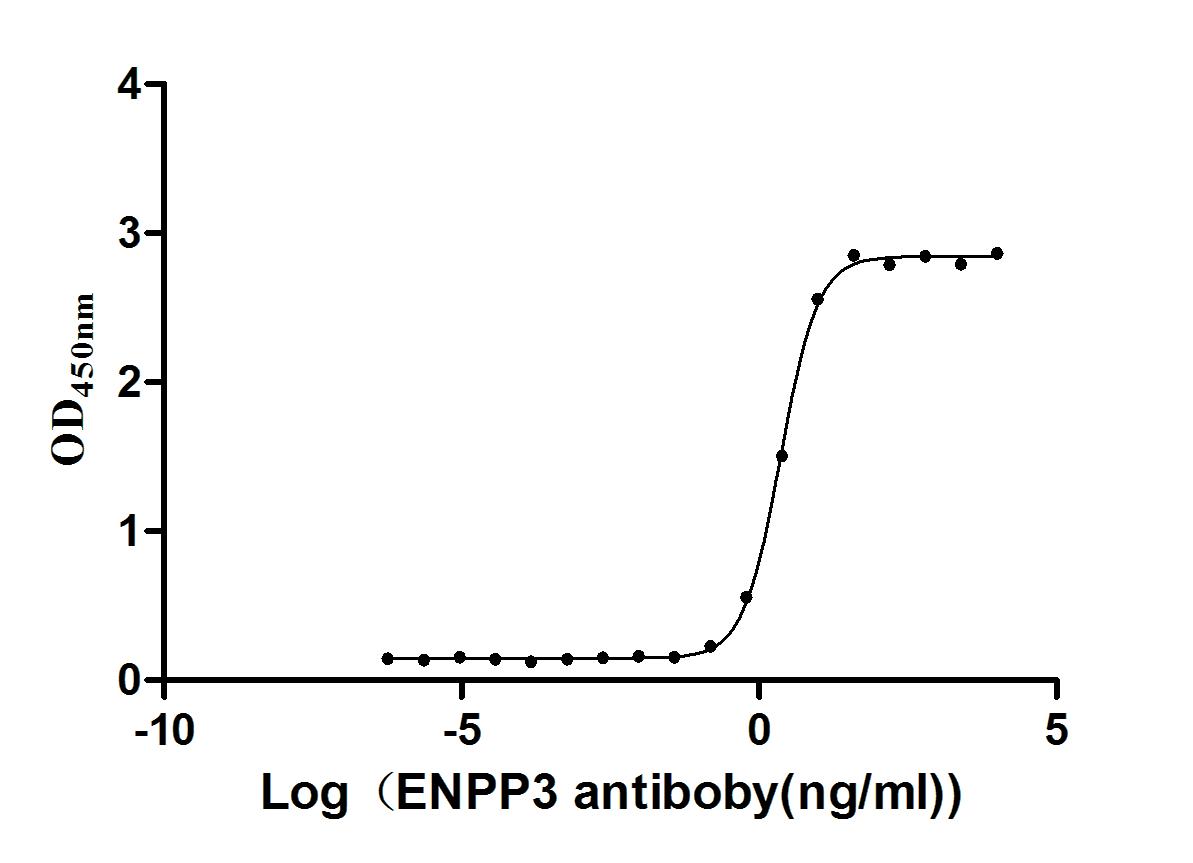Recombinant Human HCLS1-associated protein X-1 (HAX1)
-
中文名称:人HAX1重组蛋白
-
货号:CSB-YP010146HU
-
规格:
-
来源:Yeast
-
其他:
-
中文名称:人HAX1重组蛋白
-
货号:CSB-EP010146HU
-
规格:
-
来源:E.coli
-
其他:
-
中文名称:人HAX1重组蛋白
-
货号:CSB-EP010146HU-B
-
规格:
-
来源:E.coli
-
共轭:Avi-tag Biotinylated
E. coli biotin ligase (BirA) is highly specific in covalently attaching biotin to the 15 amino acid AviTag peptide. This recombinant protein was biotinylated in vivo by AviTag-BirA technology, which method is BriA catalyzes amide linkage between the biotin and the specific lysine of the AviTag.
-
其他:
-
中文名称:人HAX1重组蛋白
-
货号:CSB-BP010146HU
-
规格:
-
来源:Baculovirus
-
其他:
-
中文名称:人HAX1重组蛋白
-
货号:CSB-MP010146HU
-
规格:
-
来源:Mammalian cell
-
其他:
产品详情
-
纯度:>85% (SDS-PAGE)
-
基因名:HAX1
-
Uniprot No.:
-
别名:FLJ17042; FLJ18492; FLJ93803; HAX 1; HAX-1; HAX1; HAX1_HUMAN; Hax1a; HCLS1 and PKD2 associated protein; HCLS1 associated protein; HCLS1 associated protein X 1; HCLS1-associated protein X-1; HCLSBP1; HS 1 associated protein X 1; HS 1 binding protein; HS1 associating protein X 1; HS1 binding protein 1; HS1 binding protein; HS1-associating protein X-1; HS1-binding protein 1; HS1BP1; HSP1BP-1; OTTHUMP00000034190 ; SCN3
-
种属:Homo sapiens (Human)
-
蛋白长度:Full Length of Mature Protein
-
表达区域:2-279
-
氨基酸序列SLFDLFRGF FGFPGPRSHR DPFFGGMTRD EDDDEEEEEE GGSWGRGNPR FHSPQHPPEE FGFGFSFSPG GGIRFHDNFG FDDLVRDFNS IFSDMGAWTL PSHPPELPGP ESETPGERLR EGQTLRDSML KYPDSHQPRI FGGVLESDAR SESPQPAPDW GSQRPFHRFD DVWPMDPHPR TREDNDLDSQ VSQEGLGPVL QPQPKSYFKS ISVTKITKPD GIVEERRTVV DSEGRTETTV TRHEADSSPR GDPESPRPPA LDDAFSILDL FLGRWFRSR
-
蛋白标签:Tag type will be determined during the manufacturing process.
The tag type will be determined during production process. If you have specified tag type, please tell us and we will develop the specified tag preferentially. -
产品提供形式:Lyophilized powder
Note: We will preferentially ship the format that we have in stock, however, if you have any special requirement for the format, please remark your requirement when placing the order, we will prepare according to your demand. -
复溶:We recommend that this vial be briefly centrifuged prior to opening to bring the contents to the bottom. Please reconstitute protein in deionized sterile water to a concentration of 0.1-1.0 mg/mL.We recommend to add 5-50% of glycerol (final concentration) and aliquot for long-term storage at -20℃/-80℃. Our default final concentration of glycerol is 50%. Customers could use it as reference.
-
储存条件:Store at -20°C/-80°C upon receipt, aliquoting is necessary for mutiple use. Avoid repeated freeze-thaw cycles.
-
保质期:The shelf life is related to many factors, storage state, buffer ingredients, storage temperature and the stability of the protein itself.
Generally, the shelf life of liquid form is 6 months at -20°C/-80°C. The shelf life of lyophilized form is 12 months at -20°C/-80°C. -
货期:Delivery time may differ from different purchasing way or location, please kindly consult your local distributors for specific delivery time.Note: All of our proteins are default shipped with normal blue ice packs, if you request to ship with dry ice, please communicate with us in advance and extra fees will be charged.
-
注意事项:Repeated freezing and thawing is not recommended. Store working aliquots at 4°C for up to one week.
-
Datasheet :Please contact us to get it.
相关产品
靶点详情
-
功能:Recruits the Arp2/3 complex to the cell cortex and regulates reorganization of the cortical actin cytoskeleton via its interaction with KCNC3 and the Arp2/3 complex. Slows down the rate of inactivation of KCNC3 channels. Promotes GNA13-mediated cell migration. Involved in the clathrin-mediated endocytosis pathway. May be involved in internalization of ABC transporters such as ABCB11. May inhibit CASP9 and CASP3. Promotes cell survival. May regulate intracellular calcium pools.
-
基因功能参考文献:
- data suggest that HAX-1 may be a promoting factor for AIV H9N2 replication through desensitizing PB1-F2 from its apoptotic induction in human lung epithelial cells. PMID: 29576744
- the HAX1 gene is important for ovarian development, in which a p.Trp44X mutation may cause primary ovarian insufficiency in female patients PMID: 28681255
- The overexpression of HAX-1 might contribute to the malignant progression of glioma. PMID: 28751207
- Autophagy induction is involved in HAX1-induced cell protective mechanism, and AA127-180 serves as the functional autophagy-regulatory domain of this antiapoptotic protein. PMID: 29461873
- HAX1 is a potential oncogene, and may promote the tumorigenesis and progression of hypopharyngeal carcinoma. PMID: 28791389
- Oncogenic HAX-1 increases the proliferation, migration, and angiogenic activity of HUVECs. Findings provide unique insight into the pathogenesis of NPC. PMID: 26871467
- Results show that Grb7 and Hax1 may colocalize partially to mitochondria in EGF-treated SKBR3 cells and their interaction can affect Caspase3 cleavage of Hax1. PMID: 26869103
- results suggest that miR-223 increases the sensitivity of TNBCSCs to TRAIL-induced apoptosis by targeting HAX-1 PMID: 27618431
- The s describe the first case series of patients with CN caused by HAX1 mutation who presented with HLH. They hypothesize that severe neutropenia persists after an HLH episode in children without FHLH mutations (especially infants) because these patients have CN caused by HAX1 mutations. PMID: 28169428
- Study indicates that the overexpression of HAX-1 is essential in the development of chemoresistance in breast cancer. PMID: 28347249
- Results show that mRNA and protein levels of HAX-1 in prostate cancer cell lines were significantly higher and inhibits cell apoptosis through caspase-9 inactivation. PMID: 26323553
- HAX-1 is overexpressed in hepatocellular carcinoma and promotes cell proliferation. PMID: 26339377
- HAX1 knockdown significantly decreased the proliferation. In addition, the expression levels of ki67 and phosphorylatedakt were inhibited following HAX1 knockdown. PMID: 26062578
- HAX-1 was significantly elevated in laryngeal carcinoma. PMID: 25554539
- s showed that HAX1 promotes auto-ubiquitination and degradation of cIAPs by facilitating the intermolecular homodimerization of RING finger domain. PMID: 25275296
- HAX-1 is involved in mRNA processing as an element of P-body interaction network. PMID: 25289648
- HAX1 mutation is associated with severe congenital neutropenia. PMID: 25284454
- HAX1 is a proto-oncogene in mantle cell lymphoma. PMID: 25419709
- anti-apoptotic role of HAX-1 versus BCL-XL in cytokine-dependent bone marrow-derived cells PMID: 24910348
- Genetic correction of HAX1 in induced pluripotent stem cells from a patient with severe congenital neutropenia improves defective granulopoiesis. PMID: 23975175
- A new homozygous HAX1 deletion (exons 2-5) was found in a French Kostmann syndrome pedigree. A homozygous frameshift mutation was found in exon 3 (c.430dupG, p.Val144fs) in a 2d pedigree. Neurological retardation associated with B isoform mutations. PMID: 24482108
- HAX-1 might be an important marker for tumor progression and prognosis, as well as a potential therapeutic target of Colorectal cancer PMID: 24057929
- Hax-1 is a family of anti- and proapoptotic regulators that may modulate cell survival and death through homo- or heterodimerization. PMID: 24347163
- Studies indicate that mutations in the gene encoding HAX1 were present in patients with the autosomal recessive form of severe congenital neutropenia. PMID: 24341138
- Hax1 physically interacts with TPC1/2 C-terminal domain. PMID: 24188827
- 4 ELANE mutations, 11 HAX1 mutations and 2 G6PC3 mutations have been identified in Iranian patients with severe congenital neutropenia. PMID: 23454784
- HAX-1 mRNA is over-expressed in esophageal squamous cell carcinoma and is prognostic factor for lymphatic metastasis and survival. PMID: 23531395
- HAX-1 may be involved in the regulation of expression of bound transcripts, possibly as part of the stress response. PMID: 23164465
- These data show that HAX1 specifically interacts with influenza A virus polymerase PA in vitro and in vivo and that HAX1 interacts with the nuclear localization signal domain of PA. PMID: 23055567
- Hax-1 is a short-lived protein and that its PEST sequence dependent fast degradation by the proteasome. PMID: 22827267
- We also confirmed the interaction of HAX-1 and hSav1 in mammalian cells. PMID: 22570112
- HAX-1 promotes the proliferation, chemoresistance, invasion, and tumorigenicity of esophageal squamous cell carcinoma. PMID: 22451114
- Data suggest that Hax-1 is a new PrP-interacting partner that may play role in cell oxidative stress and anti-apoptosis physiologically and cell damage pathologically. PMID: 21301993
- hSav1 interacts with HAX1 and attenuates its protective role against apoptosis in MCF-7 breast cancer cells. PMID: 21567072
- Novel HAX1 gene mutations are associated with neurodevelopmental abnormalities in two Italian patients with severe congenital neutropenia. PMID: 20065084
- Hax1 is a novel regulator of neutrophil uropod detachment and chemotaxis through RhoA PMID: 21518791
- Our resultsvindicate that HAX-1 may not be a candidate gene for psoriasis susceptibility in the Chinese Han population. PMID: 21109726
- Full-length Grb7 and Hax-1 interact in mammalian cells and Grb7 is tyrosine phosphorylated. PMID: 20665473
- Biallelic mutations in the antiapoptotic gene HAX1 were identified in patients with autosomal recessive severe congenital neutropenia. PMID: 21206270
- identified consanguineous family with 2 patients with severe congenital neutropenia and neurological disease caused by novel, homozygous genomic deletion including exons 4-7 of the HAX1 gene; quantitative MRI showed alteration in cerebral proton density PMID: 21108402
- analysis of HAX-1 overexpression, splicing and cellular localization in tumors PMID: 20196840
- HAX-1 is a multifaceted antiapoptotic protein localizing in the mitochondria and the sarcoplasmic reticulum of striated muscle cells PMID: 19913549
- The N(pro)-HAX-1 interaction was confirmed using co-precipitation assays. PMID: 20631090
- describe congenital neutropenia patients with mutations in two candidate genes each,HAX1 and G6PC3, including 6 novel mutations PMID: 20220065
- This study is the first to demonstrate GrB activity within the mitochondrion and to identify Hax-1 cleavage as a novel mechanism for GrB-mediated mitochondrial depolarization. PMID: 20388708
- PELO is subcellularly localized at the actin cytoskeleton, interacts with HAX1, EIF3G and SRPX proteins and that this interaction occurs at the cytoskeleton; this interaction may facilitate PELO to detect and degrade aberrant mRNAs. PMID: 20406461
- HAX-1 suppresses the polyubiquitination of XIAP; formation of the HAX-1-XIAP complex inhibits apoptosis by enhancing the stability of XIAP against proteosomal degradation. PMID: 20171186
- study suggests that the novel missense c.421T>C mutation in the HAX1 gene produces a milder form of severe congenital neutropenia without apparent developmental or neurological manifestations PMID: 19796188
- Interacts with the alpha subunit of G protein G13 to promote cell migration. PMID: 15339924
- results indicate a different function and mechanism of Hax1 in apoptosis and re-opens the question of whether mammalian PARL, in addition to apoptosis, regulates mitochondrial stress response through Omi/HtrA2 processing. PMID: 19680265
显示更多
收起更多
-
相关疾病:Neutropenia, severe congenital 3, autosomal recessive (SCN3)
-
亚细胞定位:Mitochondrion. Endoplasmic reticulum. Nucleus membrane. Cytoplasmic vesicle. Cytoplasm, cell cortex. Cell membrane; Peripheral membrane protein; Cytoplasmic side. Sarcoplasmic reticulum. Cytoplasm, P-body.; [Isoform 1]: Cytoplasm. Nucleus.; [Isoform 3]: Cytoplasm. Nucleus.; [Isoform 4]: Cytoplasm. Nucleus.; [Isoform 5]: Cytoplasm.
-
蛋白家族:HAX1 family
-
组织特异性:Ubiquitous. Up-regulated in oral cancers.
-
数据库链接:
HGNC: 16915
OMIM: 605998
KEGG: hsa:10456
STRING: 9606.ENSP00000329002
UniGene: Hs.199625
Most popular with customers
-
Recombinant Human Tumor necrosis factor ligand superfamily member 8 (TNFSF8), partial (Active)
Express system: Mammalian cell
Species: Homo sapiens (Human)
-
Express system: Mammalian cell
Species: Homo sapiens (Human)
-
Recombinant Macaca fascicularis CD44 antigen (CD44), partial (Active)
Express system: Mammalian cell
Species: Macaca fascicularis (Crab-eating macaque) (Cynomolgus monkey)
-
Recombinant Macaca fascicularis lymphocyte antigen 6 family member G6D (LY6G6D) (Active)
Express system: Yeast
Species: Macaca fascicularis (Crab-eating macaque) (Cynomolgus monkey)
-
Recombinant Human Cell adhesion molecule 1 (CADM1), partial (Active)
Express system: Mammalian cell
Species: Homo sapiens (Human)
-
Recombinant Human CUB domain-containing protein 1 (CDCP1), partial (Active)
Express system: Mammalian cell
Species: Homo sapiens (Human)
-
Recombinant Mouse Cytotoxic and regulatory T-cell molecule (Crtam), partial (Active)
Express system: Mammalian cell
Species: Mus musculus (Mouse)
-
Recombinant Human Interleukin-2 (IL2) (Active)
Express system: Mammalian cell
Species: Homo sapiens (Human)


















